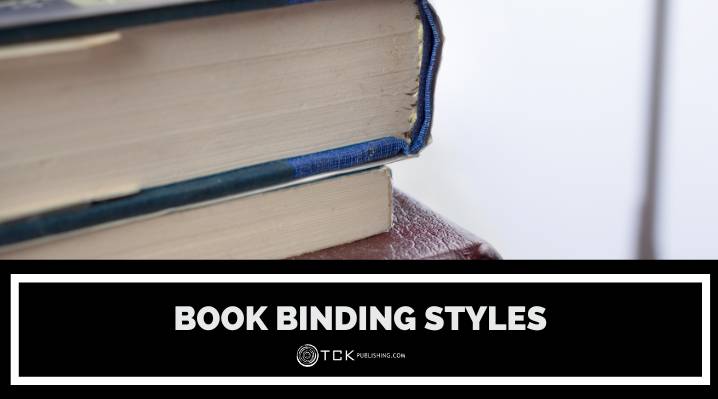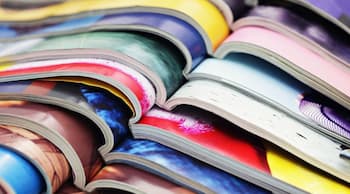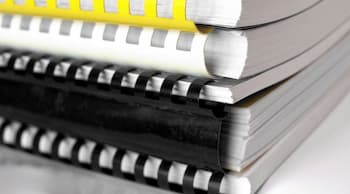
Whether you’re an aspiring author, a self-publisher, or a creative needing to compile a portfolio, you need to know about the different book binding styles so you can choose the best option for your need.
Or, if you’re simply looking for your next handicraft in the realm of book-binding, we hope this post can also give you inspiration for your upcoming project. You can create planners, journals, or even bind your own poetry compilation to give away as gifts.
What is the most common type of binding?
In our modern day, the following are the most common kinds of binding:
1. Saddle stitch binding
Traditionally, saddle stitch binding referred to hand-stitched spines of pieces of paper folded into what we call “signatures.” Oftentimes, the stitching would go from one signature to the next, and the next, until the entire document is sturdily held together by tight stitches.
In modern lingo, saddle stitching includes professional stapling, a common method for binding thin documents such as brochures, booklets, catalogues, magazines, or programs.
Instead, we have a new name for sewn pages, as outlined below.
2. PUR binding

PUR doesn’t really sound like a good name, but it’s an acronym that stands for polyurethane reactive, the main adhesive used in this kind of binding. These refer to paperbacks usually bound with a heavy cover stock glued to its spine.
This is the typical binding method used for paperback books, yearbooks, annual reports, or thick magazines. It boasts of a clean spine and “perfect binding”—almost.
3. Singer sewn binding
This traditional bookbinding method refers to a set of folded pages sewn through with a single thread. It uses no staples or adhesives, and typically only works with a thin book with a single section. But it’s a very secure method of binding, and you can choose if you want the stitching visible outside or hidden neatly inside.
4. Section sewn binding
From a single-section book, if you have several sections, you can have each section sewn and then glue all the pieces together. It might be bound with a hard cover or paperback-style, but its main component is its being sewn in sections.
5. Hardcover binding

When we think about book binding, chances are, we automatically think of beautifully bound leather volumes. That refers to hardbound, or case bound, books. These tend to be more expensive, but they are obviously one of the prettiest—and sturdiest—options for bookbinding.
In the publishing world, hardbounds clearly cost more than paperbacks, but they also emanate a higher allure for buyers. So if you’re thinking of self-publishing or you have the option with a traditional publisher, consider including hardbacks in your portfolio.
6. Spiral binding

Also known as wire or comb binding, this is popular for school workbooks and commercial documents. It makes use of a hole puncher—usually punching through the whole length of the book in one go—and a loop wire.
This is ideal for journals, planners, and workbooks where you need to lay the book flat as you work. Its commercialized method also makes it a cost-effective option for binding school materials, even super thick textbooks or workbooks!
What is the most durable book binding?
Clearly, the most durable book binding is the hardcover binding. The covers can range from cardboard, to cloth, to leather.
Some hardcovers even come with cardboard slip cases. This is ideal for boxed book sets, popular for children’s and young adult books. The beautifully-decorated slip cases push up its sale value and help it become almost instant collectible items.
Which type of book binding is best?
It’s impossible to say just which book binding is best, because they’re all designed for a specific purpose. Perhaps a better way of helping you choose would be to help you think about what your project is about:
How thick is your output?
If it’s relatively thin, consider a Singer sewn binding or PUR binding. If you’re printing a large textbook, consider a spiral binding.
What kind of project are you working on?
Is it an image-heavy work printed on glossy paper? Glossy paper tends to be heavier, and you will need a sturdier book binding. If it’s a story or a novel, consider paperback PUR and an option for a hardbound version.
What is your target audience demographic?
If you’re looking to sell your work, you need to think about your target audience demographic. Are you selling mostly towards the upper class, or the masses? This is one reason why dime novels became popular as paperbacks, because they served as engaging entertainment for the common people during that time.
How much are you willing to spend?
Yes, different binding methods require a different cash outlay, so think about your budget. If finances is an issue, comb binding is one of the most affordable options. In fact, many places sell the equipment that can let you bind your own books.
What kind of look are you going for?
The overall look and feel that you want your book to have will also factor into the kind of binding you choose. If you want a classy appeal, you will likely not want to have your poetry anthology showing its shiny staples on the spine! Consider a singer sewn binding instead.
Choosing a Book Binding Style
If you’re publishing with a company, chances are, they will have a team to guide you in making your choice. But if you’re self-publishing, the choice will be entirely up to you. Our advice is to take a look at your overall marketing plan, and then see the pricing options of the print-on-demand company you’re working with.
Some book marketing experts typically recommend adding a hardback option, even if you don’t print as many of them, just for the aesthetic appeal that tends to affect sales. This applies for both fiction and nonfiction, so do your research and make an informed decision.
Did you find this post helpful? Let us know in the comments below!
If you enjoyed this post, then you might also like:
- What Are Light Novels? How a Niche Format Is Taking over the Publishing World
- What Is a Publishing House?
- Your Guide to Publishing Imprints: What They Are and Why Publishers Have Them
- A Brief History of Self-Publishing: From Gutenberg to KDP
Yen Cabag is the Blog Writer of TCK Publishing. She is also a homeschooling mom, family coach, and speaker for the Charlotte Mason method, an educational philosophy that places great emphasis on classic literature and the masterpieces in art and music. She has also written several books, both fiction and nonfiction. Her passion is to see the next generation of children become lovers of reading and learning in the midst of short attention spans.
